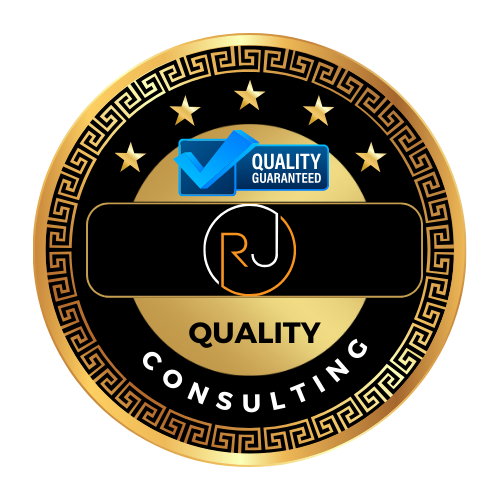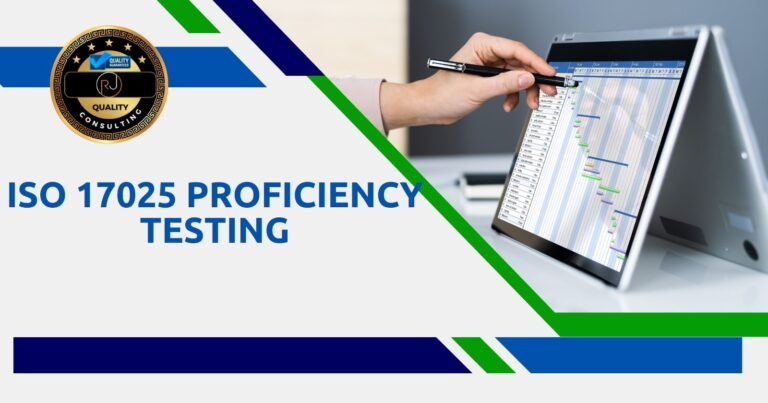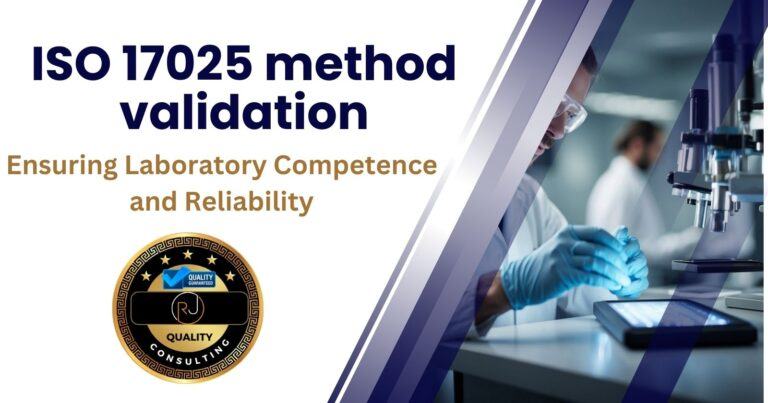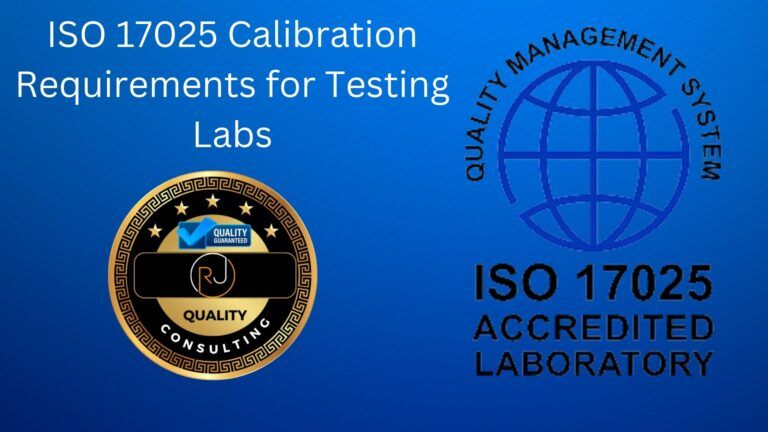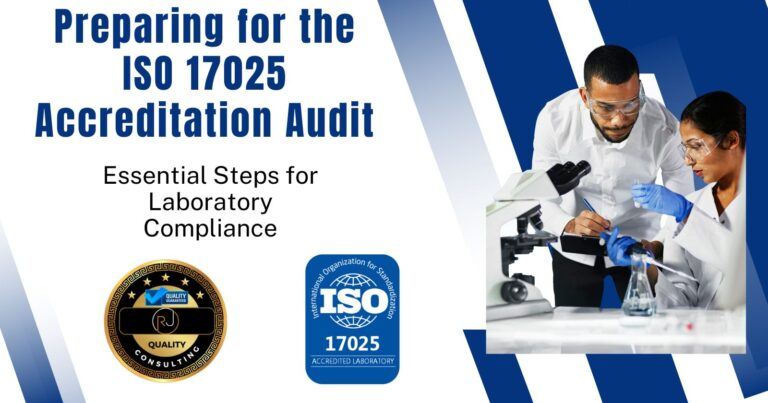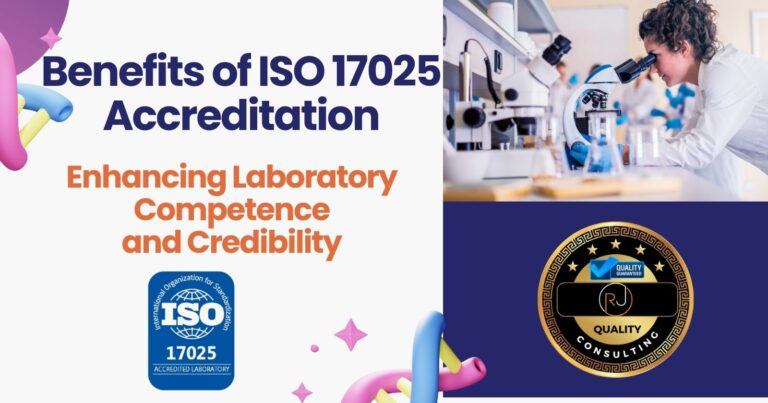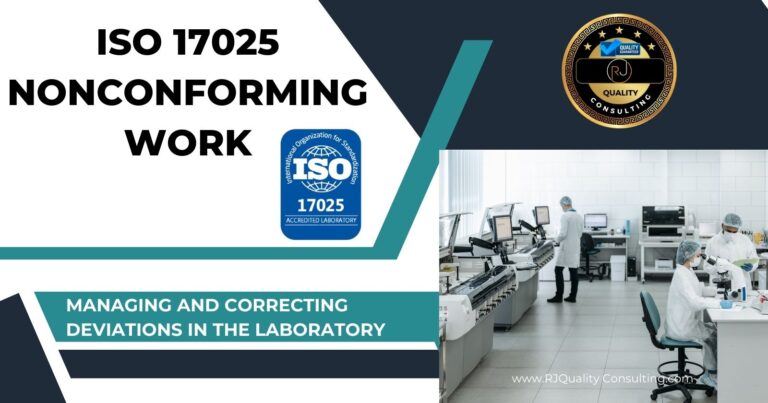ISO 17025 Impartiality Requirements Explained
ISO 17025 Impartiality is not just a word tossed around lightly in the world of laboratory accreditation; it’s the very pillars that support the credibility of laboratory results. When a lab claims adherence to the ISO/IEC 17025 international standard, it takes on the heavy responsibility to execute testing and calibration without bias, ensuring the data it provides can stand unshakable against scrutiny and doubt. So, what does this really entail?
Put simply, ISO 17025 impartiality is about freedom from conflicts of interest, ensuring that no external pressures, financial gains, or personal beliefs sway the laboratory’s work. The standard’s Section 4.1 spells this out in no uncertain terms. Laboratories must actively identify potential threats to their impartiality and take decisive steps to eliminate or minimize such risks. This means routine checks and balances, ongoing training, and a culture that puts the scientific method above all else.
The video on impartiality requirements underscores how essential it is to understand the ‘what’ and ‘why’ behind each guideline. A laboratory that grapples with these concepts is more likely to uphold the integrity of its testing and calibration services, translating to trust from clients and regulatory bodies alike. It’s clear that having firm policies in place is good, but grasping the core principles behind those policies is even better.
Knowing this, you’re poised to learn how a laboratory moves from understanding impartiality to manifesting it daily. The next section sheds light on the concrete actions that make impartiality a lived reality in the lab, not just a section in the ISO manual.
Book a FREE 45-Minute Consultation
During the Consultation We Will Give You a Clear Direction and Path For You to Move Forward with Your Certification or Accreditation Goals
Concrete Actions for Upholding ISO 17025 Impartiality
ISO 17025 Impartiality is not just theoretical: it’s a PRACTICAL necessity. Laboratories achieving or maintaining accreditation under this standard need to establish clear protocols that demonstrate their commitment to unbiased work. How, then, does a laboratory embody this principle? The key is in the everyday actions and the systems put in place to prevent any hint of prejudice.
Laboratories must cultivate an environment where all personnel are acutely aware of the importance of impartial conduct. Training programs and regular reminders about the impact of bias on test results can foster a culture of objectivity. Furthermore, transparent communication channels should be encouraged, allowing issues regarding impartiality to be promptly addressed.
Documentation Needed to Meet ISO 17025 Impartiality Requirements
So, what documentation do you actually need to show objective evidence that you are meeting the requirements stated in section 4.1 of the ISO/IEC 17025 standard? In other words, what would an external auditor be looking for? To answer these questions, let’s break down the clause elements and analyze them and then ask these questions.
First of all, the standard defines impartiality in section 3.1: Check out the image below to see the details:
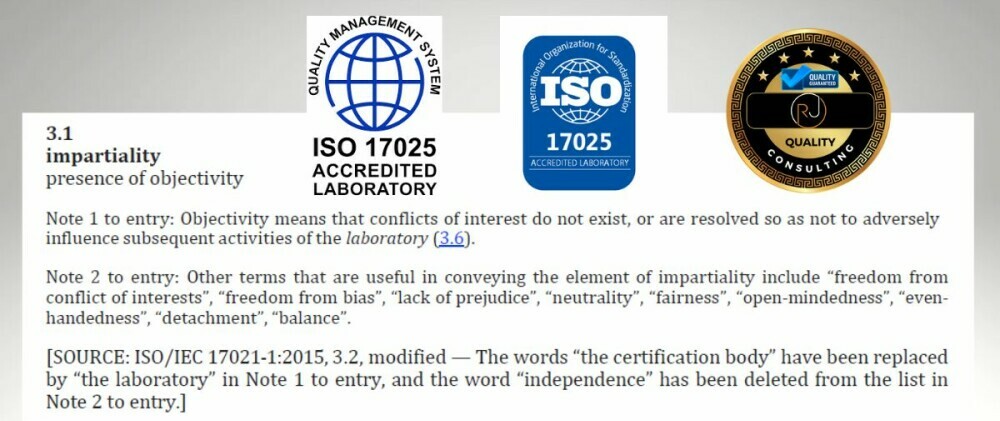
You will notice the standard offers two notes to help clarify what it means by impartiality. This demonstrates that impartiality in section 4.1 of the standard is tied to section 4.2 of the standard which is all about confidentiality. From a documentation standpoint, it has been my experience, as an auditor, to see a combined policy showing both impartiality (section 4.1) and confidentiality (section 4.2) in the same policy statement.
Then, it would be a document that everyone in the laboratory would be trained to. It would be important at this point to ensure that each employee has this policy within that employees training record. Another way to document this is to put this policy within an employee handbook and have everyone employee sign this and retain that as a record.
Now, let’s take a look at section 4.1 of the standard. The meat and potatoes, if you will. Check out the image below directly from the ISO/IEC 17025:2017 standard.
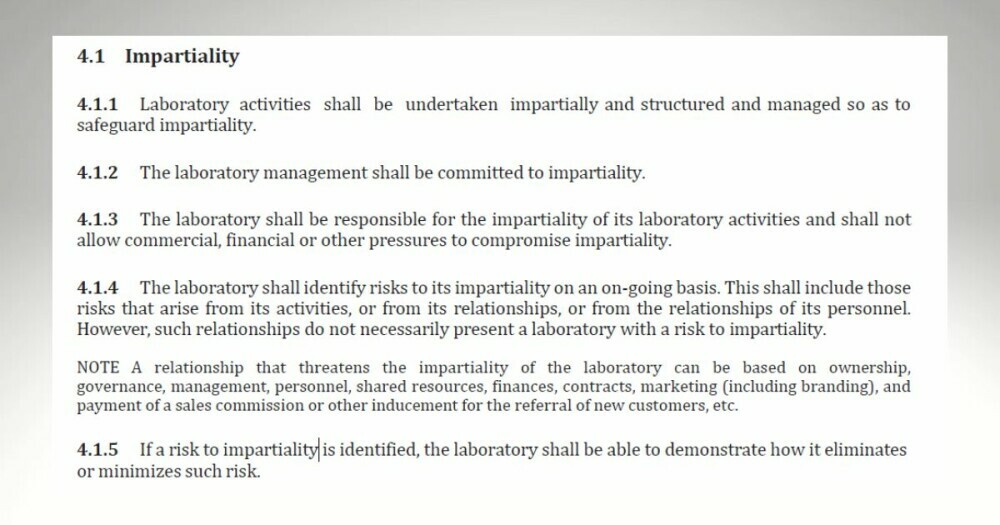 So, if you want to understand what documentation you would need to satisfy section 4.1 ISO 17025 impartiality, you need to divide section 4.1 into three main sections which can translate into three documents. We’ll add one more document to include a training record.
So, if you want to understand what documentation you would need to satisfy section 4.1 ISO 17025 impartiality, you need to divide section 4.1 into three main sections which can translate into three documents. We’ll add one more document to include a training record.
Section 1 would include clause elements 4.1.1 through 4.1.3.
By studying these three clauses, one can see that a policy is needed to ensure adherence to these clause elements. How can I tell this? Well, first of all, each of these clause elements contains a “shall” statement. “Shall” statements always indicate a requirement.
Logic tells us that in order to “prove” that laboratory activities shall be undertaken impartially and structured and managed so as to safeguard impartiality and that management shall be committed to impartiality, and that the laboratory is responsible for the impartiality all points to the fact, that the laboratory needs a policy to make this all work.
That being said, now let’s take a look at section 4.1.4.
The first sentence is the key sentence here. “The laboratory shall identify risks to its impartiality on an on-going basis”. This means that some documentation needs to “prove” this is being accomplished. The term on-going basis means some type of regularity. Here are two ways this clause element can be documented :
- An agenda item discussed during Management Review with meeting minutes indicating this was discussed and any applicable notes associated with risk to impartiality. Even if the question was asked “has anyone experienced any risk to impartiality since the last Management Review meeting?” Even if everyone said “no” and this was documented, this would meet the requirement if this was an agenda item at every Management Review. This would be on an on-going basis.
- A documented annual impartiality training
Both of these types of documentation would satisfy section 4.1.4.
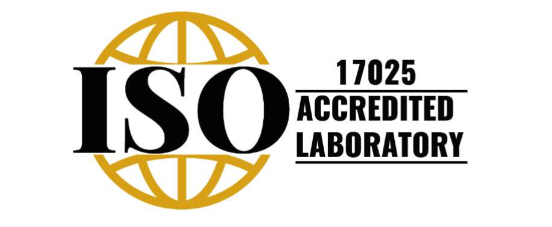
So, now we get into section 4.1.5.
If a risk to impartiality is identified, the laboratory shall be able to demonstrate how it eliminates or minimizes such risk. Clearly, this needs to be documented. The word demonstrate indicates this. So, what is needed here as far as documentation? I would say a risk register or spreadsheet identifying a risk to impartiality with a pre and post mitigation level associated with it.
So, there you have it. four documents are needed to satisfy ISO 17025 Impartiality Requirements
- Impartiality and confidentiality policy where everyone is trained to the policy
- training records showing employees have read and understood the policy
- Management Review meeting minutes or documented annual impartiality training
- risk register.
The policies and procedures forming the foundation of an impartiality-oriented laboratory must be well-documented and accessible. This includes conflict of interest policies, ensuring that all personnel are clear on what constitutes a conflict and the steps to take should one arise. Additionally, labs should actively avoid situations where commercial, financial, or other pressures could potentially influence the lab’s analytical results.
A firm stance on quality control further illustrates a laboratory’s dedication to impartiality. Rigorous checks, including blind samples and peer reviews, serve as both a deterrent to biased behavior and ensuring the validity of results ISO 17025 style. An unyielding approach to objectivity sets the stage for the high levels of trust required by ISO 17025 accreditation.
Navigating the Hazards: Threats to Laboratory Neutrality

In my work, I’ve come to learn that staying impartial isn’t just about setting policies; it’s also about recognizing the threats that can compromise neutrality. Risk to impartiality refers to anything that threatens a lab’s objectivity, and ISO 17025 takes this seriously.
You might wonder, ‘What does a risk to impartiality look like in a real-world setting?’ I’ve come across a few scenarios where personal relationships or financial pressures could skew a lab technician’s judgment. Even external pressures, like the expectations of stakeholders, can unknowingly influence test results.
Common risks often stem from the human element: biases, preconceived notions, or potential conflicts of interest. These can be as overt as a lab analyst favoring results desired by a known client or as subtle as supplier-sponsored training exerting undue influence.
ISO 17025 emphasizes not just identifying these risks, but actively managing them. Laboratories need to meticulously document and counteract these risks to maintain their accreditation. This might involve regular staff training on the ethical conduct or implementing robust quality control checks that flag discrepancies automatically.
In the next section, we’ll discuss how a lab goes beyond merely spotting these risks to effectively mitigating them through solid management practices. Proactive and reactive processes ensure that impartiality isn’t just an intention – it becomes the bedrock of reliable lab operations.
The Cycle of Improvement: Sustaining Impartial Standards

Maintaining impartiality isn’t a one-time act; it’s a cycle of constant improvement that demands attention and action. In environments where precision and reliability are paramount, laboratories can’t afford to stagnate. A lab’s process for managing impartiality must evolve alongside technological advancements and industry standards.
ISO/IEC 17025 reminds us that impartiality isn’t simply about identifying risks; it’s also about implementing robust methods to manage and neutralize those threats. Best practices in this area include regular employee training, transparent procedure documentation, and an independent review process to monitor adherence to impartiality standards.
For those managing a lab, employing effective risk assessment tools is vital. These tools can range from internal audits to feedback mechanisms. They’re designed to scrutinize the laboratory environment and processes, ensuring every potential risk to impartiality is accounted for and addressed.
The video and blog sources both speak to the importance of embracing tools that facilitate the detection and mitigation of risks. From record-keeping software that logs incidents to analytic procedures that highlight areas of concern, technology plays a crucial role in preserving the integrity of laboratory results.
As we transition to the discussion on regular review and improvement, it’s important to understand that this cycle is not only about preventing breaches in impartiality but also about elevating the lab’s overall quality. Vigilant monitoring and a committed approach to addressing feedback pave the way for a credible, trustworthy laboratory environment.
Now if you would like to gain an even better understanding of the ISO 17025 impartiality requirements, I have included a great video from the accreditation body that I audit ISO/IEC 17025 labs under. PJLA. In this video, one of the program managers of PJLA gets into a very detailed presentation of these requirements. I think you will find this very helpful.
Conclusion: Commitment to ISO 17025 Impartiality
Now that we’ve walked through the detailed landscape of impartiality within ISO/IEC 17025 accredited laboratories, it’s clear that maintaining an unbiased approach is more than just a procedural checkbox; it’s the lifeline of trust in laboratory results.
We’ve unpacked the nuances of recognizing and managing risks to neutrality and emphasized the cycle of continuous improvement that bolsters the adherence to this crucial principle. Remember, it’s not a one-time setup but a dynamic, ongoing process.
Standards evolve, technologies advance, and bureaucratic requirements change, yet the value of impartiality remains steadfast. This commitment ensures that your laboratory’s findings are respected and trusted by all stakeholders, from regulatory bodies to the end consumers.
Embrace the vigilance required to maintain this cornerstone of scientific practice. It’s this dedication that will not only uphold the reputation of your work but also contribute to the broader scientific community by ensuring integrity and quality in each test conducted and result reported.
In the spirit of progress, seek out new resources, attend relevant workshops, and engage with the wider community. By fostering a culture of unwavering objectivity within our laboratories, we’re not just improving our own processes; we’re enhancing the bedrock of scientific exploration and discovery for all.
